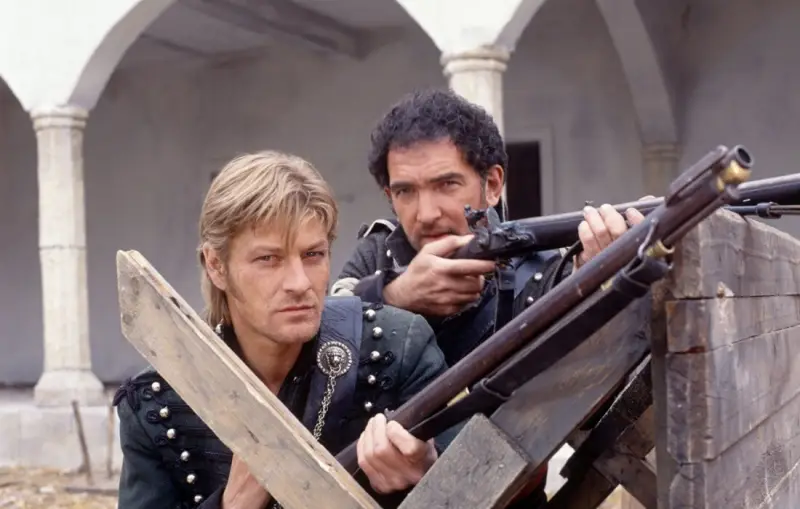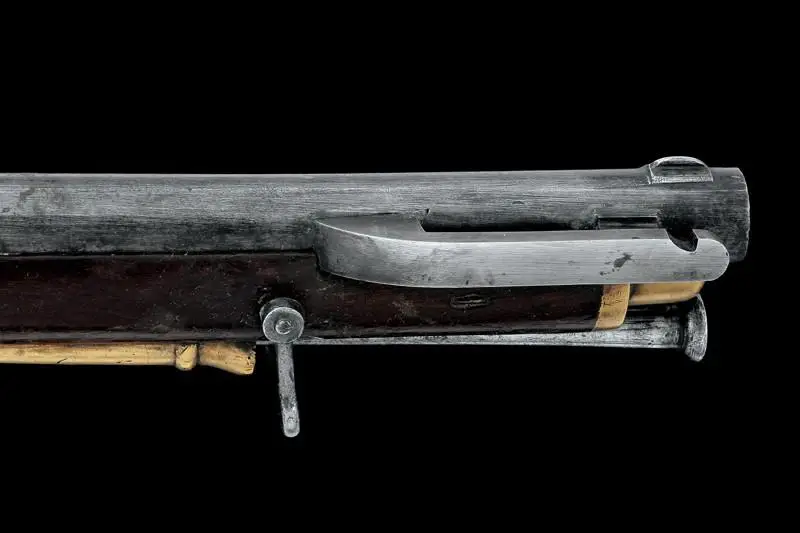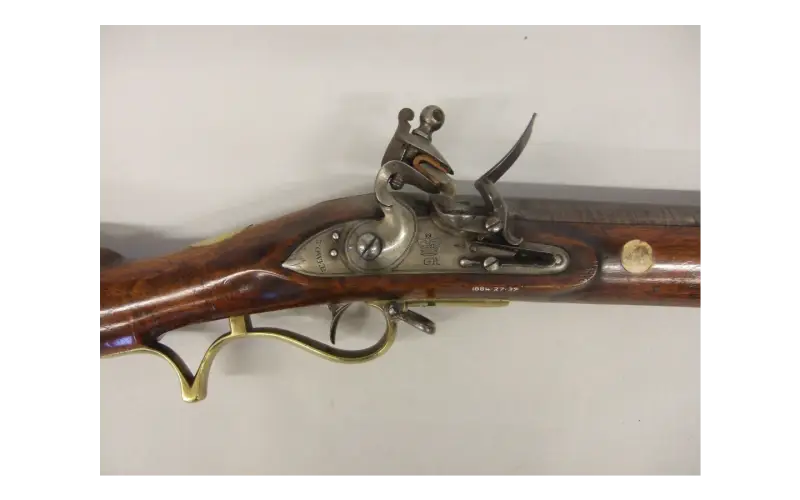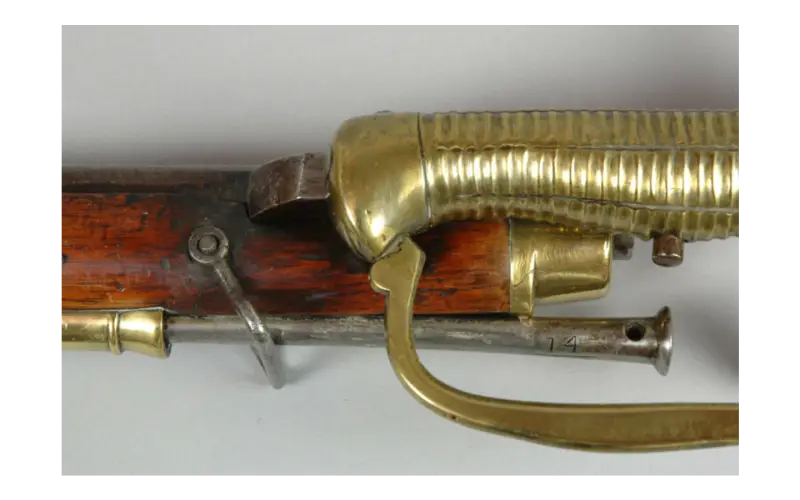First of the First: The Rifle of a Man Called Baker

A still from the series “The Adventures of the Royal Gunner Sharpe” (1993-2008). Sharpe has a Baker rifle in his hands...
“To Whitsuntide, sir,” replied Harper majestically.
“It’s the Baker rifle, the bayonet and me,” Sharpe explained.
The Adventures of Gunner Sharpe, Bernard Cornwell
History weapons. As you know, the British have many surnames and names associated with working professions. The same Harry Potter is none other than a “potter”, the name Smith translates as “blacksmith”, but the surname Baker means “baker”. And it was just a man with this last name who managed to go down in the history of arms as the creator of the first rifle, moreover, with a flintlock, adopted by the British army.
And it so happened that at the end of the 12th - beginning of the XNUMXth century, Napoleon began to widely use column tactics and at the same time scattered formation, which led to the widespread creation of chasseur battalions and regiments, and later even corps. True, not all rangers in these units were then armed with rifled weapons. The task was not so much to shoot accurately, but... “to adapt to the terrain.” Therefore, rifled guns were usually issued only to the XNUMX best shooters per company, and in the forward chain, and all the rest, as before, had smooth-bore guns, but with barrels shortened for convenience. The British, having the Brown Bess smoothbore musket, excellent in its qualities, could not help but notice the losses that, even before the start of the Napoleonic wars, the colonists in the USA, armed with rifled rifles, inflicted on them.

Baker rifle used in Brazil. Photo by A. Dobress
In 1774, the British in the United States tested the Fergusson rifle, which was loaded from the breech. In 1796, the Ordnance Survey purchased several of these rifles from the famous gunsmith Durce Egg. The weapon was tested, but seemed unnecessarily complex. At the same time, it became obvious that the army needed a rifle; it was only important to get the best of the best. It was intended to equip soldiers with rifles from elite and specially trained rifle corps, as well as pre-existing rifle units, such as the 5th Battalion of the 60th Infantry Regiment. In January 1800, it was decided that it was necessary to adopt a rifled gun and begin training the best infantry units in its use.
This is where Ezekiel Baker offered his model to the military!
It is known about Baker that he was initially trained by the gunsmith Henry Nock, and subsequently worked for this master. But in 1794 Baker somehow became an arms contractor for the British Ordnance Survey. Based in a small workshop in London Minorius, he was engaged in the production of locks and barrels. For some time, Baker collaborated with lock manufacturer James Negus. Baker also held government contracts for smoothbore muskets and pistols and produced them for the East India Company.
The British rushed with new weapons. The decision was made in January, and already in February, tests of new rifled guns took place at the Woolwich training ground near London. True, no documents exist for this time, except for the registered travel expenses of repairman Baker in Woolwich.

French Baker rifle battery lock. Brazilian model. Photo by A. Dobress
According to Baker himself, it was like this:
Interestingly, the design of the rifle was by no means innovative, but contained the best characteristics of continental models. Moreover, Baker's first two applications were rejected on the grounds that they were of the size and caliber of a military musket and were therefore considered too heavy, but the third model was approved and ultimately became the first rifle model adopted by the British Army. As Baker himself said:
It appears that Colonel Manningham was a clear-headed man and played a vital role in the Council's decision-making process. It was Manningham who provided Baker with a German Jaeger rifle with the recommendation to copy it. This is how the Baker rifle came with a barrel only 30 inches long and a caliber of 15,9 mm. The rifle did resemble the German Jaeger rifle model, and was also similar to other Continental rifles, but the real innovation was the Baker quarter-turn rifling, which was said to provide high accuracy. The selection of the third model of the Ezekiel Baker rifle as the weapon for the new rifle corps took two years. In addition, it was also necessary to approve his equipment and, in particular, his green uniform, which was different from the traditional British red one. The new uniform was approved for eight companies, all of which were equipped with Baker rifles. The first order was for 800 examples, specifically for the 95th Regiment of Foot, and placed with gunsmiths in London and Birmingham, including such gunsmiths as Egg, Knock, Baker, Pritchett, Brander, Wilkes, Bennett, Harrison and Thompson. The first rifles cost 36 shillings with a pencil case in the butt and 32 shillings for rifles without a pencil case.

Bayonet mounting plate. Photo by A. Dobress
In addition to the document on the adoption of the rifle for service "it was also noted that the barrel is less prone to contamination from frequent shooting than other barrels", did not require as frequent cleaning as other rifles, and at the same time had all the advantages in terms of accuracy at a distance of three hundred yards.
Baker's main improvements were to reduce barrel length, overall dimensions and weight, and to reduce the caliber of the barrel. In 1805, Ezekiel Baker founded his own production and attracted the attention of the Prince of Wales, who became his patron. Soon Baker was appointed court armorer. Further encouragement from the Prince of Wales led to Baker establishing his own testing workshop, in which he subjected his weapons to a special "Fire, Water and Target" test and marked them with special stamps. Ezekiel Baker's private store and factory grew into a prominent competitor to other gun manufacturers. The Society for the Encouragement of Arts and Manufactures awarded him three silver medals for his developments in the field of fuses and bullet molds. It was noted that the Baker rifle not only showed its accuracy, but also
Experience with the Napoleonic War led to changes in the Baker rifle. The second model was equipped with a Newland lock, and the third model appeared in 1806 with a trigger guard shaped like a pistol grip. In addition, it had a pencil case on the butt of a characteristic shape.
By 1809, English marksmen were equipped with the third model guns, which became standard by 1823. All rifle fittings (e.g. stock tang, side plate, trigger guard) of the rifle were made of brass. The rifle came with a sling and was sighted at 200 yards.
The need for the rifle was such that Baker subcontracted production to approximately 20 or more gunsmiths, although he himself produced one during the period 1805-1815. produced only 712 rifles. Between 1805 and 1808, the Ordnance Survey took into its depots some 10 English-made Baker rifles. By the end of the Napoleonic War, this number had increased to 078. It was from 14 that the Baker Cavalry Carbine entered service with the 000th Light Dragoons. As a result, an average of 1813 Baker rifles of various models were produced in England. Birmingham alone supplied 10 complete rifles, as well as 2000 barrels and 14 rifle locks.
Overall, as noted, the weapon was a standard rifle of the day, caliber .0,625 in (15,9 mm) and weighing about nine pounds (4,08 kg). The overall length was 43 and three quarters inches (1162 mm), the camouflage brown barrel was only about 30 inches (762 mm) long. The lead bullet gauge was 0,615 inches, requiring greased spacers. The Baker rifle stock was made of English walnut and was of high quality. The flintlock was usually marked TOWER and had a crown above the letters GR in front of the lock. An experienced shooter with this rifle could achieve a rate of fire of three shots per minute, while a less experienced shooter could count on two shots per minute.

An English-made lock marked TOWER. Photo of the Pitt Rivers Museum. Oxford University Museum
Rifle Corps officers allowed their soldiers to load their rifles at their discretion, provided they could demonstrate the required marksmanship. As a result, it was possible to ensure that shooters could shoot at a distance of 150 to 200 yards twice a minute, while hitting a tall target. This was a previously unknown level of accuracy compared to the unreliability of the standard musket at ranges greater than 75 yards. However, from a shooter who could shoot birds and rabbits for food at a certain distance, it was naturally expected that he would shoot just as accurately at moving French or other soldiers. For this purpose, by the way, there were two sights on the barrel of the Baker rifle - front and rear, in order to shoot at close range and at a distance. By the way, the barrel had a brown coating so that its shine would not give away the shooter!

The handle of a sword bayonet. Photo of the Pitt Rivers Museum. Oxford University Museum
The first bayonet for the Baker rifle was a single-edged flat blade 23 inches (60 cm) long. In Russia, such bayonets were called daggers. The handle was made of brass and had a bow like a saber. The bayonet weighed 800g and, as later reports confirmed, was difficult to shoot when attached to the muzzle of a rifle. After 1815 it was replaced by a lighter bayonet. However, contemporary diaries and letters from riflemen indicate that they liked their sword bayonet, although it was rarely used in hand-to-hand combat for various reasons. But it was very useful for chopping wood, digging holes, cutting and frying meat, and in general it turned out to be very convenient for a soldier to use.
It is interesting that the recruits for the rifle regiments were selected to be of higher quality, so to speak, than for the infantry regiments. Most of the shooters already knew how to read and write, as evidenced by surviving diaries and letters. Rifle officers, unlike line regiment officers, often dined with their soldiers and thus got to know them well. Specially made moving targets were used to train shooters, which increased their skills in hitting moving enemy soldiers at a distance. It was noted that the Baker rifle, on average, could achieve an average accuracy of hitting the target equal to one shot in 20. While for the army musket this figure was one shot in 200! The best example of its high fighting qualities was the shot of the shooter Plunkett, who, during the retreat to Corunna, killed the French general Colbert with a shot in the head, hitting the latter at a distance of 600 yards, and after that he also shot the adjutant running to help Colbert. Overall, for its time, the relatively short Baker rifle turned out to be an innovative and convenient weapon that played a significant role in the wars of the British Empire.
Information